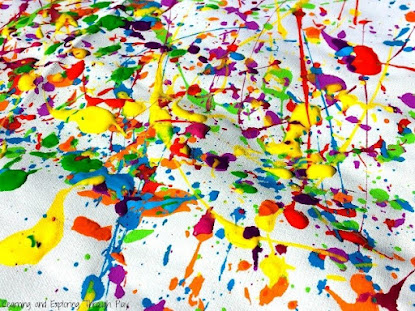Knowing is half the battle, and when it comes to art, it
shines through the most in expressing it. Here are some activities to help you
in your own journey!
IF YOU WANT TO SEE THE ORIGINAL DOCS , CHECK OUT THE LINK BELOW:
ORIGINAL DOCS
Crayon Etching
Crayon etching, or scratch art, is a type of
art-making that makes use the properties of waxy crayons.
The activity is done by heavily coloring all over a
piece of paper using 3-4 light bright colored crayons. Then, the bright colors
are colored over by a black crayon until the bright colors are faintly seen or
completely covered. Afterwards, a sharp tool is used to sketch a picture
directly over the black, scraping away and scratching in thin, thick, wavy,
etc. lines. Creating many textures is encouraged.
Crayon Etching is a classic visual arts lesson. It
allows all students to be successful as long as directions are followed. Not
only are the student products good, but the process is enjoyable and engaging
for students of all levels and abilities. This lesson is appropriate for
students of all levels.
Insights: It teaches the child how to be patient with
their work, to trust in the process, and that hidden beauty can be seen when
effort is put in.
Objectives
·
To learn in a simplified
way how the art of etching is done
·
To create textures by
combining various scratching techniques
Materials:
·
Wax Crayons
·
Paper
·
Scratching tool (sticks,
broken pencil, Bobbie pins, etc.)
Examples:
References:
a)
https://askingthelot.com/what-is-the-importance-of-crayon-etching/
b)
https://hellocreativefamily.com/wp-content/uploads/2017/05/DSCF3690ed.jpg
c)
c. https://i.pinimg.com/736x/d5/1e/76/d51e769ef4938244268e50d3475e3844--etchings-crayons.jpg
Contour Drawing
A contour drawing is an outline of a shape without any
shading, texture, or tone. Contour drawings have very little detail and only
consist of lines. Considered one of the most basic types of drawing, contour
drawing is what many of us learn first as artists.
The activity is done by looking at the model and not
the paper, letting the tool (pencil, crayon, charcoal, etc.) follow the outline
shape. The tool cannot be picked up; this makes sure outcome is only one
continuous line. The students may “feel” for the edges of the paper.
Contour Drawing is an exercise where the artist
focuses on drawing the outline of a subject or object. The objective of this
kind of exercise is to focus on the shape of the subject instead of its
details.
Insights: It teaches the child how to focus on the
bigger picture rather than spend too much time on one small part, that art
isn’t supposed to be perfect but must merely capture the essence of the
subject.
Objectives
·
to experience bending and
moving of the figure
·
to limber the arm and
shoulder movements for sketching
Materials
·
paper (bond paper,
newsprint, newspaper, etc.)
·
sketching tools (variety
of charcoal, crayons, felt markers, pencils, etc.)
Examples:
References:
a)
https://adventureswithart.com/5-types-of-contour-drawing/
b)
https://doncorgi.com/blog/what-is-contour-drawing/
c)
https://i.pinimg.com/originals/c5/4b/f9/c54bf94d1057aeca3c2c807d2f09a1e2.jpg
d)
http://www.youthareawesome.com/wp-content/uploads/2013/02/Blind-Contour-Drawing.jpeg
Drip Painting
Drip painting is an abstract art form popularized by
artist Jackson Pollock, in which paint is made to drip on canvas to create
dynamic and unique effects.
This activity is done by taking a half sheet of
newspaper, tearing holes into it, and laying it over paper. Loading the brush
with paint to the point of dripping, drip over the newspaper stencil and change
color using a clean brush and repeat. After letting it dry, make a new stencil
with different holes and repeat the process. Afterwards, when the paint is
dried, draw around shapes with magic marker or black paint.
Drip painting is a technique which merges the
controllable and uncontrollable factors in painting.
Insights: It teaches the child to freely express
themselves and to realize that sometimes mistakes add to the beauty of the
result.
Objectives
·
to help develop a feeling
for the abstract
·
to experiment with a
Jackson Pollock technique
Materials
·
liquid acrylic paint
·
brush or stick
·
newspaper
·
paper (newsprint, Manila)
Examples:
References:
a.
https://www.guidepatterns.com/drip-painting-how-tos.php
b.
http://blog.canvaslot.com/jackson-pollock-master-drip-technique/
c.
https://www.pinterest.com/pin/255438610097973916/
d.
http://mymodernmet.com/dripping-and-splattering-watercolor-paintings/






